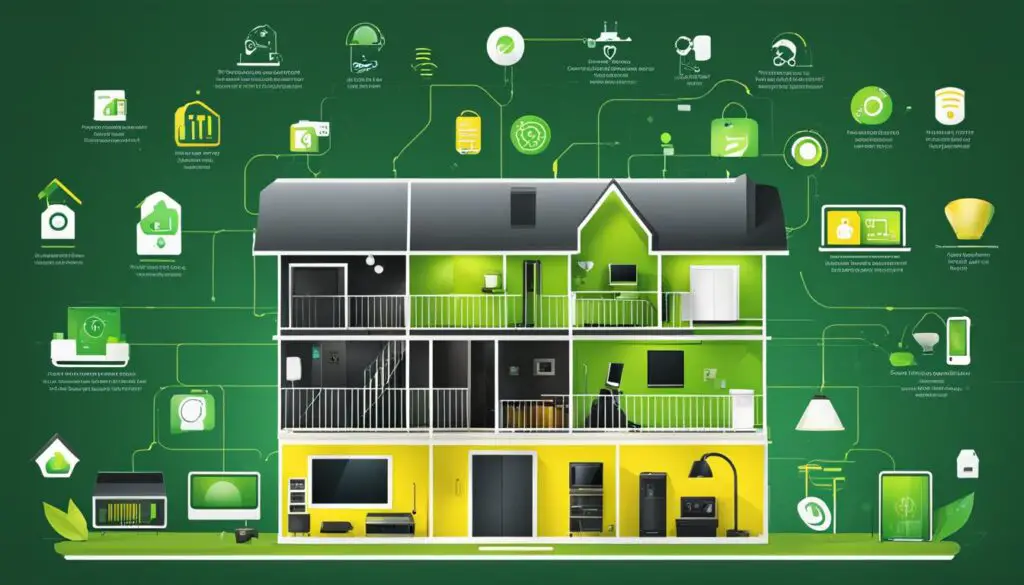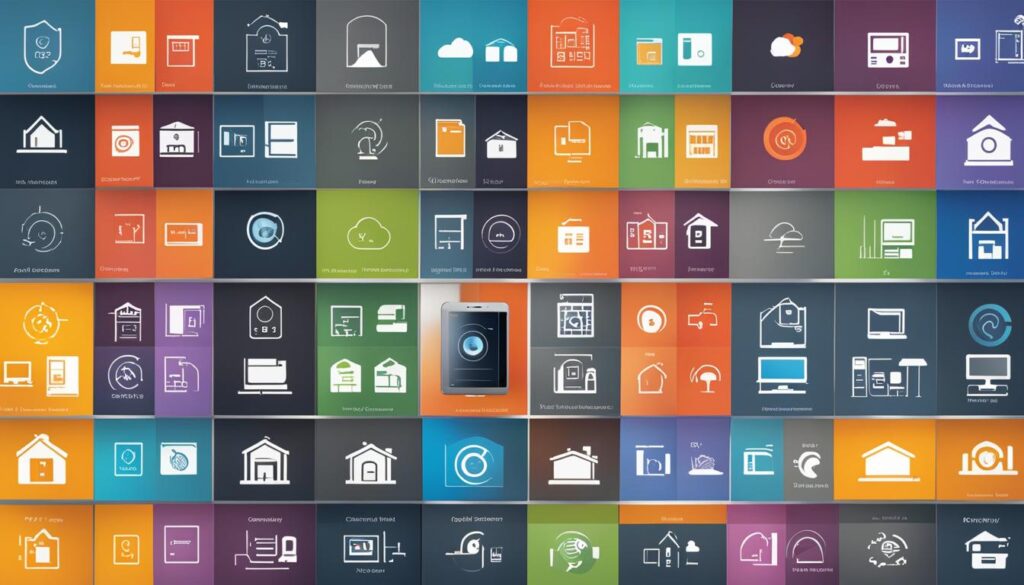When it comes to building a smart home, choosing the right platform is crucial. With so many options available, such as Apple Home, Google Home, Amazon Alexa, and Samsung SmartThings, it can be overwhelming to make a decision. In this guide, I will provide you with all the information you need to know to choose the best smart home platform for your needs. From understanding what a smart home platform is to considering factors like compatibility and features, I will help you navigate the world of smart home platforms.
Table of Contents
Key Takeaways:
- Choosing the right smart home platform is essential for a seamless smart home experience.
- Consider factors like compatibility, features, and your preferred voice assistant when making a decision.
- Smart home platforms provide centralized control and the ability to create custom routines and scenes.
- Verify compatibility and carefully set up your devices to ensure smooth operation.
- Ensure Wi-Fi strength and security for optimal performance.
What is a Smart Home Platform and Do I Need One?
A smart home platform is a software framework that allows you to control and manage multiple smart devices from different manufacturers through a single app. It provides organization and convenience by allowing you to group devices and create automations. While it is not necessary to have a smart home platform to use smart home devices, having one offers numerous benefits, such as centralized control and the ability to create custom routines and scenes.
Having a smart home platform simplifies the control of your smart devices, as you can control them all from one app, eliminating the need to switch between multiple apps for different devices. Furthermore, grouping devices enables you to control multiple devices together with just one command, creating a streamlined and efficient smart home experience. With the ability to create custom routines and scenes, you can automate tasks and create personalized settings that cater to your specific needs and preferences.
However, not all smart home platforms are created equal, and compatibility is a crucial factor to consider. It is important to ensure that the smart home platform you choose is compatible with the devices you already own or plan to purchase.
For example, if you already have several smart devices from a particular brand, it would be wise to choose a smart home platform that is compatible with that brand to ensure seamless integration and optimal functionality.
| Smart Home Platform Features | Smart Home Platform Compatibility |
|---|---|
| Centralized control | Supports devices from various manufacturers |
| Custom routines and scenes | Compatible with existing smart devices |
| Device grouping | Seamless integration with preferred devices |

Four Things to Consider When Picking a Smart Home Platform
When it comes to selecting a smart home platform, there are four important factors you should take into consideration. These factors will help you make an informed decision and ensure that you choose the right platform for your needs.
1. Smartphone Compatibility
The first thing to consider is the compatibility of the smart home platform with the smartphone you use. Some platforms work best with specific devices and operating systems. For example, Apple HomeKit is designed to seamlessly integrate with iOS devices, while Google Home is optimized for Android smartphones. Therefore, it is crucial to check if the platform you are considering is compatible with your smartphone before making a decision.
2. Device Compatibility
Another crucial factor to consider is the compatibility of the smart home platform with the devices you already own or plan to purchase. Ensure that the platform supports the smart devices you currently have or intend to add to your smart home ecosystem. This will prevent any compatibility issues and ensure that all your devices can be controlled through a single platform.
3. Voice Assistant Integration
If you use a voice assistant like Amazon Alexa or Google Assistant, it’s important to consider the voice assistant integration of the smart home platform you choose. Some platforms work seamlessly with specific voice assistants, allowing you to control your smart devices using voice commands. Ensure that the platform you choose supports your preferred voice assistant to enhance the overall smart home experience.
4. Desired Features
Lastly, think about the specific features you want in a smart home platform. Different platforms offer varying capabilities and functionalities. Consider if you prioritize energy management, home security, or other specific features. This will help you narrow down your options and select a smart home platform that aligns with your requirements.
Considering these four factors when picking a smart home platform will enable you to make a well-informed decision. Take into account smartphone compatibility, device compatibility, voice assistant integration, and desired features to choose a platform that seamlessly integrates with your existing technology and enhances your smart home experience.

The Importance of Wi-Fi in Smart Home Platforms
A reliable Wi-Fi connection is essential for the seamless functioning of smart home platforms. Whether you’re controlling your lights, adjusting the thermostat, or monitoring security cameras, a stable Wi-Fi connection ensures that your commands are promptly executed and data is transmitted efficiently.
Most smart home devices operate on the 2.4 GHz Wi-Fi frequency, which provides a longer range and better penetration through walls and floors. However, the 2.4 GHz frequency can be more susceptible to interference from neighboring Wi-Fi networks, microwave ovens, and other electronic devices.
To overcome the limitations of the 2.4 GHz frequency, many modern routers also support the 5 GHz frequency. This higher frequency offers faster speeds and is less prone to interference. However, it has a shorter range and may not penetrate obstacles as effectively as the 2.4 GHz frequency.
When setting up your smart home platform, it’s crucial to choose a strategic location for your router. Placing it centrally and away from obstructions can help optimize Wi-Fi coverage throughout your home. Additionally, it’s important to consider factors like Wi-Fi channel congestion and router limitations to ensure smooth communication between your devices.
Did you know? Newer Wi-Fi protocols like Wi-Fi 6E are emerging, offering increased bandwidth, improved device handling, and reduced interference. However, it’s important to note that for Wi-Fi 6E to be effective, both your router and smart home devices need to support this protocol.
To summarize, a robust Wi-Fi connection is an integral part of a reliable smart home platform. Careful consideration of Wi-Fi frequencies, channel congestion, and router placement can go a long way in ensuring a seamless and connected smart home experience.
Wi-Fi Frequency Comparison
| Wi-Fi Frequency | Advantages | Disadvantages |
|---|---|---|
| 2.4 GHz | Longer range | More susceptible to interference |
| 5 GHz | Faster speeds | Shorter range |
| Wi-Fi 6E | Increased bandwidth, reduced interference | Requires compatible devices |
Understanding Smart-Home Standards in Platforms
Smart home platforms operate on different standards, which dictate how devices communicate with each other and with the platform. When choosing a smart home platform, it is important to consider the supported smart home standards to ensure compatibility with your devices and create a seamless ecosystem.
There are several smart home standards in existence, including:
- Thread
- Zigbee
- LoRa
- Z-Wave
Each standard has its own advantages and uses, so it’s important to understand their capabilities before making a decision. Here is a brief overview of each:
| Standard | Description |
|---|---|
| Thread | A low-power mesh networking protocol designed for smart home devices. It provides reliable connectivity and is ideal for larger homes with many devices. |
| Zigbee | An open standard that allows devices from different manufacturers to communicate with each other. It is widely used in smart homes and provides good compatibility. |
| LoRa | Short for Long Range, LoRa is a wireless communication technology that enables long-range and low-power connectivity for smart home devices. It is ideal for devices that operate over large areas. |
| Z-Wave | A wireless communication protocol designed specifically for smart home devices. It offers a secure and reliable connection, but devices using Z-Wave require a Z-Wave hub. |
It’s worth noting that some smart home platforms have standalone smart hubs, while others integrate the necessary technology into devices like smart speakers or routers. This integration allows for a more streamlined setup and eliminates the need for additional hubs.
When evaluating different smart home platforms, check if they support the smart home standards that your devices use. This will ensure that all your devices can work together seamlessly within the platform’s ecosystem, creating a truly connected and efficient smart home.
Verifying Smart-Home Support and Setup
Before purchasing smart home devices, it is crucial to verify their compatibility with your chosen smart home platform. Ensuring compatibility ensures seamless integration and functionality. Here are the steps to follow:
1. Check for Compatibility Logos
Look for compatibility logos on the packaging or the device manufacturer’s website. Common logos to watch for include:
- Google Assistant: Devices that work with Google Assistant are compatible with platforms like Google Home and Nest.
- Amazon Alexa: Devices that work with Amazon Alexa are compatible with platforms like Amazon Echo and Ring.
- Apple HomeKit: Devices that work with Apple HomeKit are compatible with platforms like Apple HomePod and Apple TV.
By ensuring compatibility with your chosen smart home platform, you can be confident that your devices will work seamlessly together.
2. Follow Setup Instructions
Once you have verified compatibility, follow the setup instructions provided by the manufacturer of each device. These instructions will guide you through the process of connecting the device to your smart home platform.
During the setup process, you may be prompted to connect your device to your Wi-Fi network and download the corresponding app for control and management.
3. Carefully Choose Device Locations
When setting up your smart home devices, consider their physical placement within your home. For example, if you have smart lights, ensure they are installed in the appropriate fixtures throughout your home for optimal functionality and convenience.
Proper device placement can enhance the overall performance and effectiveness of your smart home setup.
4. Select Appropriate Device Names
Choosing clear and descriptive names for your smart home devices can make controlling them easier and more intuitive. For example, naming a smart light in your living room “Living Room Light” instead of a generic name like “Light 1” will make it simpler to give voice commands or create automation routines.
Take the time to name your devices thoughtfully in order to streamline control and automate actions within your smart home platform.
Image of a person setting up smart home devices – illustrating the process of verifying compatibility and following setup instructions.
| Step | Action |
|---|---|
| 1 | Check for compatibility logos on packaging or website. |
| 2 | Follow setup instructions provided by the device manufacturer. |
| 3 | Carefully choose device locations for optimal functionality. |
| 4 | Select appropriate and descriptive names for devices. |
By following these steps, you can ensure a smooth setup and integration process for your smart home devices within your chosen platform.
Troubleshooting and Security in Smart Home Platforms
As with any technology, smart home platforms may encounter occasional issues that require troubleshooting. Here are some common problems and their solutions:
Troubleshooting Wi-Fi Connectivity
A stable Wi-Fi connection is crucial for the smooth operation of smart home platforms. If you’re experiencing connectivity issues, consider the following:
- Check for Wi-Fi channel congestion: Interference from other nearby devices can disrupt your Wi-Fi signal. Use a Wi-Fi analyzer tool to identify the least congested channel and change your router’s settings accordingly.
- Upgrade your router: Older routers may not provide sufficient bandwidth for the growing number of smart devices in your home. Consider upgrading to a router that supports higher speeds and offers better coverage.
- Ensure strong Wi-Fi signal strength: Position your router in a central location within your home to maximize signal range and strength. Avoid placing it near appliances or physical barriers that could cause signal interference.
Enhancing Smart Home Platform Security
Security is a critical aspect of any smart home platform. To protect your smart home devices and data, follow these essential security measures:
- Choose a strong password for your Wi-Fi network: A weak password makes it easier for hackers to gain unauthorized access to your devices. Use a combination of letters, numbers, and special characters to create a secure password.
- Create separate networks for smart home devices: Setting up a guest network or segregating your smart home devices from your main network adds an extra layer of protection. This prevents unauthorized access to your personal devices and data.
- Keep devices and apps up to date: Regularly update the firmware of your smart home devices and ensure that the associated mobile apps are running the latest versions. Updates often include security patches that address vulnerabilities.
- Choose reputable manufacturers: Opt for smart home devices from trusted manufacturers that prioritize security. Research the manufacturer’s track record and customer reviews to ensure that their products have a solid security foundation.
“The security of smart home platforms should never be taken lightly. By implementing proper troubleshooting techniques and following essential security practices, users can ensure a safe and reliable smart home experience.”
Smart Home Platform Security and Troubleshooting Table
| Security Measures | Troubleshooting Techniques |
|---|---|
| Create a strong Wi-Fi password | Check for Wi-Fi channel congestion |
| Create separate networks for smart devices | Upgrade your router |
| Regularly update devices and apps | Ensure strong Wi-Fi signal strength |
| Choose reputable manufacturers |
Table: Smart Home Platform Security and Troubleshooting
By following these troubleshooting techniques and implementing the necessary security measures, you can ensure a smooth and secure experience with your chosen smart home platform.
Conclusion
Choosing the right smart home platform is a crucial step in building your smart home. With a wide range of options available, it can be overwhelming to make a decision. However, by considering important factors such as compatibility, features, and standards, you can confidently choose a platform that suits your needs.
When selecting a smart home platform, it is essential to ensure compatibility with your existing devices or those you plan to purchase. By verifying compatibility before making a purchase, you can avoid frustration and ensure that all your devices seamlessly connect and work together.
Additionally, carefully setting up your smart home devices according to the platform’s instructions is essential for smooth operation. This includes choosing appropriate device locations and creating distinctive names for easy control and automation within the platform.
By choosing the right smart home platform, you can enjoy the convenience, organization, and automation that smart homes offer. Whether it’s managing your devices from a single app or creating custom routines and scenes, a well-chosen platform will provide you with a seamless and secure smart home experience.
FAQ
What is a smart home platform?
A smart home platform is a software framework that allows you to control and manage multiple smart devices from different manufacturers through a single app.
Do I need a smart home platform?
While it is not necessary to have a smart home platform to use smart home devices, having one offers numerous benefits, such as centralized control and the ability to create custom routines and scenes.
What factors should I consider when choosing a smart home platform?
When choosing a smart home platform, consider factors such as smartphone compatibility, device compatibility, preferred voice assistant, and desired features.
How important is Wi-Fi in smart home platforms?
A reliable Wi-Fi connection is essential for smart home platforms to function properly. It is important to choose a good spot for your router and consider factors like channel congestion and router limitations.
What are smart home standards in platforms?
Smart home platforms operate on different standards, such as Thread, Zigbee, LoRa, and Z-Wave. These standards determine how devices communicate with each other and with the platform.
How do I verify smart-home support and set up my devices?
Before purchasing smart home devices, verify if they are compatible with your chosen smart home platform. Look for compatibility logos and follow the setup instructions provided by the manufacturer of each device.
What are some common troubleshooting and security measures in smart home platforms?
Troubleshooting common issues in smart home platforms can involve checking Wi-Fi channel congestion, upgrading routers, and ensuring strong Wi-Fi signal strength. When it comes to security, choose a strong Wi-Fi password and keep devices and apps up to date with the latest security patches.


